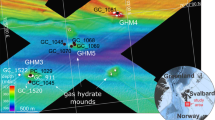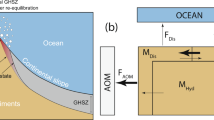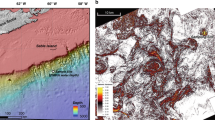Abstract
Anaerobic oxidation of methane at the sulfate–methane transition in marine sediments is generally considered to be a near-perfect barrier against methane release from the seabed, but the mechanisms involved are not well understood. On the basis of a survey of Baltic Sea sediments we show that a highly variable amount (0–100%) of subseafloor methane leaks through the sulfate–methane transition. The diffusive methane flux to the sediment–water interface is often high, reaching over 2 mmol m−2 d−1. Even though anaerobic methane oxidation is thermodynamically and kinetically favoured where methane fluxes are high, there is no evidence of methane oxidation in concentration, isotope and modelling results. Cores that lacked anaerobic methane oxidation had high modelled organic matter mineralization rates, suggesting that a possible mechanism could be high electron donor availability due to elevated H2 concentrations, as has been predicted by laboratory studies. We show that methane leakage across the sulfate–methane transition is widespread in organic-rich marine sediments.
This is a preview of subscription content, access via your institution
Access options
Access Nature and 54 other Nature Portfolio journals
Get Nature+, our best-value online-access subscription
$32.99 / 30 days
cancel any time
Subscribe to this journal
Receive 12 print issues and online access
$259.00 per year
only $21.58 per issue
Buy this article
- Purchase on SpringerLink
- Instant access to full article PDF
Prices may be subject to local taxes which are calculated during checkout





Similar content being viewed by others
Data availability
Sediment porewater methane concentration, sulfate concentration, methane stable carbon isotope ratios, DIC stable carbon isotope ratios, total organic carbon stable carbon isotope ratios and porosity are freely available in the database PANGAEA, https://doi.org/10.1594/PANGAEA.935085. Water column salinity, temperature and dissolved oxygen profiles are also freely available in PANGAEA, https://doi.org/10.1594/PANGAEA.780460.
References
Dlugokencky, E. J. et al. Observational constraints on recent increases in the atmospheric CH4 burden. Geophys. Res. Lett. 36, L18803 (2009).
Saunois, M. et al. The global methane budget 2000–2017. Earth Syst. Sci. Data 12, 1561–1623 (2020).
Rosentreter, J. A. et al. Half of global methane emissions come from highly variable aquatic ecosystem sources. Nat. Geosci. 14, 225–230 (2021).
Conrad, R. Importance of hydrogenotrophic, aceticlastic and methylotrophic methanogenesis for methane production in terrestrial, aquatic and other anoxic environments: a mini review. Pedosphere 30, 25–39 (2020).
Beulig, F., Røy, H., Glombitza, C. & Jørgensen, B. B. Control on rate and pathway of anaerobic organic carbon degradation in the seabed. Proc. Natl Acad. Sci. USA 115, 367–372 (2018).
Reeburgh, W. S. Oceanic methane biogeochemistry. Chem. Rev. 107, 486–513 (2007).
Martens, C. S. & Berner, R. A. Interstitial water chemistry of anoxic Long Island Sound sediments. 1. Dissolved gases. Limnol. Oceanogr. 22, 10–25 (1977).
Iversen, N. & Jørgensen, B. B. Anaerobic methane oxidation rates at the sulfate–methane transition in marine sediments from Kattegat and Skagerrak (Denmark). Limnol. Oceanogr. 30, 944–955 (1985).
Ettwig, K. F. et al. Nitrite-driven anaerobic methane oxidation by oxygenic bacteria. Nature 464, 543–548 (2010).
Raghoebarsing, A. A. et al. A microbial consortium couples anaerobic methane oxidation to denitrification. Nature 440, 918–921 (2006).
McGinnis, D. F., Greinert, J., Artemov, Y., Beaubien, S. E. & Wüest, A. Fate of rising methane bubbles in stratified waters: how much methane reaches the atmosphere? J. Geophys. Res. 111, C09007 (2006).
Martens, C. S. & Goldhaber, M. B. Early diagenesis in transitional sedimentary environments of the White Oak River Estuary, North Carolina. Limnol. Oceanogr. 23, 428–441 (1978).
La, W. et al. Sulfate concentrations affect sulfate reduction pathways and methane consumption in coastal wetlands. Water Res. 217, 118441 (2022).
Hoehler, T. M., Alperin, M. J., Albert, D. B. & Martens, C. S. Field and laboratory studies of methane oxidation in an anoxic marine sediment: evidence for a methanogen–sulfate reducer consortium. Glob. Biogeochem. Cycles 8, 451–463 (1994).
Martens, C. S. & Klump, J. V. Biogeochemical cycling in an organic-rich coastal marine basin—I. Methane sediment–water exchange processes. Geochim. Cosmochim. Acta 44, 471–490 (1980).
Treude, T., Krüger, M., Boetius, A. & Jørgensen, B. B. Environmental control on anaerobic oxidation of methane in the gassy sediments of Eckernforde Bay (German Baltic). Limnol. Oceanogr. 50, 1771–1786 (2005).
Piker, L., Schmaljohann, R. & Imhoff, J. F. Dissimilatory sulfate reduction and methane production in Gotland Deep sediments (Baltic Sea) during a transition period from oxic to anoxic bottom water (1993–1996). Aquat. Microb. Ecol. 14, 183–193 (1998).
Sawicka, J. E. & Brüchert, V. Annual variability and regulation of methane and sulfate fluxes in Baltic Sea estuarine sediments. Biogeosciences 14, 325–339 (2017).
Thang, N. M. et al. The impact of sediment and carbon fluxes on the biogeochemistry of methane and sulfur in littoral Baltic Sea sediments (Himmerfjärden, Sweden). Estuaries Coasts 36, 98–115 (2013).
Egger, M. et al. Rapid sediment accumulation results in high methane effluxes from coastal sediments. PLoS ONE 11, e0161609 (2016).
Hilligsøe, K. M. et al. Methane fluxes in marine sediments quantified through core analyses and seismo-acoustic mapping (Bornholm Basin, Baltic Sea). Geochim. Cosmochim. Acta 239, 255–274 (2018).
Mathys, M., Theiβen, O., Theilen, F. & Schmidt, M. Seismic characterisation of gas-rich near surface sediments in the Arkona Basin, Baltic Sea. Mar. Geophys. Res. 26, 207–224 (2005).
Schneider von Deimling, J. et al. A low frequency multibeam assessment: spatial mapping of shallow gas by enhanced penetration and angular response anomaly. Mar. Pet. Geol. 44, 217–222 (2013).
Winterhalter, B. On sediment patchiness at the BASYS coring site, Gotland Deep, Baltic Sea. Baltica 14, 18–23 (2001).
Winterhalter, B. On the Geology of the Bothnian Sea, an Epeiric Sea That Has Undergone Pleistocene Glaciation Bulletin 258 (Geological Survey of Finland, 1972).
Berner, R. A. Early Diagenesis: a Theoretical Approach (Princeton Univ. Press, 1980).
Egger, M., Riedinger, N., Mogollon, J. M. & Jørgensen, B. B. Global diffusive fluxes of methane in marine sediments. Nat. Geosci. 11, 421–425 (2018).
Knab, N. J., Dale, A., Lettmann, K., Fossing, H. & Jørgensen, B. B. Thermodynamic and kinetic control on anaerobic oxidation of methane in marine sediments. Geochim. Cosmochim. Acta 72, 3746–3757 (2008).
Hoehler, T. M., Alperin, M. J., Albert, D. B. & Martens, C. S. Thermodynamic control on hydrogen concentrations in anoxic sediments. Geochim. Cosmochim. Acta 62, 1745–1756 (1998).
Wegener, G., Krukenberg, V., Riedel, D., Tegetmeyer, H. E. & Boetius, A. Intercellular wiring enables electron transfer between methanotrophic Archaea and bacteria. Nature 526, 587–590 (2015).
Hoehler, T. M., Alperin, M. J., Albert, D. B. & Martens, C. S. Apparent minimum free energy requirements for methanogenic Archaea and sulfate-reducing bacteria in an anoxic marine sediment. FEMS Microbiol. Ecol. 38, 33–41 (2001).
Pohlman, J. W. et al. Anaerobic methane oxidation in low-organic content methane seep sediments. Geochim. Cosmochim. Acta 108, 184–201 (2013).
Timmers, P. H. A. et al. Growth of anaerobic methane-oxidizing Archaea and sulfate-reducing bacteria in a high-pressure membrane capsule bioreactor. Appl. Environ. Microbiol. 81, 1286–1296 (2015).
Lloyd, K. G., Alperin, M. J. & Teske, A. Environmental evidence for net methane production and oxidation in putative ANaerobic MEthanotrophic (ANME) archaea. Environ. Microbiol. 13, 2548–2564 (2011).
Martens, C. S., Albert, D. B. & Alperin, M. J. Biogeochemical processes controlling methane in gassy coastal sediments—Part 1. A model coupling organic matter flux to gas production, oxidation, and transport. Cont. Shelf Res. 18, 1741–1770 (1998).
Zehnder, A. J. B. & Brock, T. D. Methane formation and methane oxidation by methanogenic bacteria. J. Bacteriol. 137, 420–432 (1979).
Kelley, D. S. et al. A serpentinite-hosted ecosystem: the lost city hydrothermal field. Science 307, 1428–1434 (2005).
Hornafius, J. S., Quigley, D. & Luyendyk, B. P. The world’s most spectacular marine hydrocarbon seeps (Coal Oil Point, Santa Barbara Channel, California): quantification of emissions. J. Geophys. Res. 104, 20703–20711 (1999).
Gülzow, W., Rehder, G., Deimling, V. S. J., Seifert, T. & Tóth, Z. One year of continuous measurements constraining methane emissions from the Baltic Sea to the atmosphere using a ship of opportunity. Biogeosciences 10, 81–99 (2013).
Jakobs, G. et al. Seasonal and spatial methane dynamics in the water column of the central Baltic Sea (Gotland Sea). Cont. Shelf Res. 91, 12–25 (2014).
Jacobs, E. et al. Upwelling-induced trace gas dynamics in the Baltic Sea inferred from 8 years of autonomous measurements on a ship of opportunity. Biogeosciences 18, 2679–2709 (2021).
Gülzow, W., Gräwe, U., Kedzior, S., Schmale, O. & Rehder, G. Seasonal variation of methane in the water column of Arkona and Bornholm Basin, western Baltic Sea. J. Mar. Syst. 139, 332–347 (2014).
Humborg, C. et al. High emissions of carbon dioxide and methane from the coastal Baltic Sea at the end of a summer heat wave. Front. Mar. Sci. 6, 493 (2019).
Graham, L. P. Climate change effects on river flow to the Baltic Sea. Ambio 33, 235–241 (2004).
Hansson, D., Eriksson, C., Omstedt, A. & Chen, D. Reconstruction of river runoff to the Baltic Sea, AD 1500–1995. Int. J. Climatol. 31, 696–703 (2011).
Neumann, T. Climate-change effects on the Baltic Sea ecosystem: a model study. J. Mar. Syst. 81, 213–224 (2010).
Andersson, A. et al. Projected future climate change and Baltic Sea ecosystem management. Ambio 44, 345–356 (2015).
Best, A. I. et al. Shallow seabed methane gas could pose coastal hazard. Eos 87, 213–220 (2006).
Meischner, D. & Rumohr, J. A light-weight, high momentum gravity corer for subaqueous sediments. Senckenberg. Marit. 6, 105–117 (1974).
Lapham, L. L., Jorgensen, B. B., Fossing, H. & Rehder, G. Biogeochemical parameters in sediment cores from MSM 16/1 August 2010 Baltic Gas. PANGAEA https://doi.org/10.1594/PANGAEA.935085 (2021).
Rehder, G. & Glockzin, M. Physical oceanography during Maria S. Merian cruise MSM16/1. PANGAEA https://doi.org/10.1594/PANGAEA.780460 (2012).
Leipe, T. et al. Particulate organic carbon (POC) in surface sediments of the Baltic Sea. Geo-Mar. Lett. 31, 175–188 (2011).
Reeburgh, W. S. Methane consumption in Cariaco Trench waters and sediments. Earth Planet. Sci. Lett. 28, 337–344 (1976).
Dickens, G. R., Koelling, M., Smith, D. C. & Schnieders, L. Rhizon sampling of pore waters on scientific drilling expeditions: an example from the IODP Expedition 302, Arctic Coring Expedition (ACEX). Sci. Drill. 4, 22–25 (2007).
Tarpgaard, I. H., Røy, H. & Jørgensen, B. B. Concurrent low- and high-affinity sulfate reduction kinetics in marine sediments. Geochim. Cosmochim. Acta 75, 2997–3010 (2011).
Cline, J. D. Spectrophotometric determination of hydrogen sulfide in natural waters. Limnol. Oceanogr. 14, 454–458 (1969).
Hall, P. O. J. & Aller, R. C. Rapid, small-volume, flow injection analysis for ΣCO2 and NH4+ in marine and freshwaters. Limnol. Oceanogr. 37, 1113–1119 (1992).
Berner, R. A. Principles of Chemical Sedimentology (McGraw-Hill, 1971).
Sahores, J. J. & Witherspoon, P. A. Diffusion of light paraffin hydrocarbons in water from 2°C to 80°C. In Advances in Organic Geochemistry (eds Hobson, G. D. & Speers, G. C.) 219–230 (Pergamon, 1970).
Lerman, A. Geochemical Processes: Water and Sediment Environments (Wiley, 1979).
Iversen, N. & Jørgensen, B. B. Diffusion coefficients of sulfate and methane in marine sediment: influence of porosity. Geochim. Cosmochim. Acta 57, 571–578 (1993).
Lide, D. R. CRC Handbook of Chemistry and Physics 87th edn (CRC Press, 2006).
Orcutt, B. N. & Meile, C. D. Constraints on mechanisms and rates of anaerobic oxidation of methane by microbial consortia: process-based modeling of ANME-2 Archaea and sulfate reducing bacteria interactions. Biogeosciences 5, 1587–1599 (2008).
Jin, Q. & Bethke, C. M. Predicting the rate of microbial respiration in geochemical environments. Geochim. Cosmochim. Acta 69, 1133–1143 (2005).
Dale, A. W., Regnier, P. & Van Cappellen, P. Bioenergetic controls on anaerobic oxidation of methane (AOM) in coastal marine sediments: a theoretical analysis. Am. J. Sci. 306, 246–294 (2006).
Thang, N. M. Biogeochemical Controls on Carbon and Sulfur Cycling in Baltic Sea Sediments. PhD thesis, Univ. Bremen (2013).
Thamdrup, B. & Canfield, D. E. Pathways of carbon oxidation in continental margin sediments off central Chile. Limnol. Oceanogr. 41, 1629–1650 (1996).
Thamdrup, B., Fossing, H. & Jørgensen, B. B. Manganese, iron, and sulfur cycling in a coastal marine sediment, Aarhus Bay, Denmark. Geochim. Cosmochim. Acta 58, 5115–5129 (1994).
Boudreau, B. P. Diagenetic Models and their Implementation: Modeling Transport and Reactions in Aquatic Sediments (Springer, 1997).
DiToro, D. M. Sediment Flux Modeling (Wiley, 2001).
Laier, T. & Jensen, J. B. Shallow gas depth-contour map of the Skagerrak–western Baltic Sea region. Geo-Mar. Lett. 27, 127–141 (2007).
Acknowledgements
We thank the captain and crew of the research vessel RV Maria S. Merian. We also thank J. Pedersen and K. Bomholt Oest for analytical expertise. This work was part of the BALTIC GAS project, funded by the European Community’s Seventh Framework Programme (FP/2007-2013) with the joint Baltic Sea research and development programme, BONUS (grant 217246, B.B.J.). Additional funding came from the Independent Research Fund Denmark (grant 1026-00159B, B.B.J.) and from the US Department of Energy (grant DE-SC0020369, K.G.L.). This is UMCES contribution 6394.
Author information
Authors and Affiliations
Contributions
Conceptualization: L.L.L., H.F., J.B.J., B.B.J. Data curation: L.L.L. Methodology: L.L.L., H.F., S.F., J.B.J. Formal analysis: L.L.L., J.B.J., M.J.A., W.H. Investigation: L.L.L., J.B.J., M.J.A., K.G.L., B.B.J. Visualization: L.L.L., B.B.J., J.B.J. Funding acquisition: H.F., T.F., B.B.J. Project administration: H.F., G.R., B.B.J. Supervision: H.F., T.F., B.B.J. Writing—original draft: L.L.L., K.G.L., B.B.J. Writing—review & editing: all authors.
Corresponding author
Ethics declarations
Competing interests
The authors declare no competing interests.
Peer review
Peer review information
Nature Geoscience thanks David Valentine and the other, anonymous, reviewer(s) for their contribution to the peer review of this work. Primary Handling Editor: Tom Richardson, in collaboration with the Nature Geoscience team.
Additional information
Publisher’s note Springer Nature remains neutral with regard to jurisdictional claims in published maps and institutional affiliations.
Extended data
Extended Data Fig. 1 Map of the Baltic Sea region with coring sites.
a) Details of the framed areas are shown in subsequent figures as numbered: Extended data figure (EDF) 3 covers Arkona Basin, Extended Data Fig. 4 covers Bornholm Basin, Extended Data Fig. 5 covers Bothnian Sea, and Extended Data Fig. 6 covers Bothnian Bay. Brown areas represent organic-rich, Holocene mud (Geological Survey of Denmark and Greenland). b) Detail of coring sites in the Gotland Basin showing coring locations across two transects with details shown in Fig. 1 and Extended Data Fig. 2. The bathymetry basemap was acquired from HELCOM (https://helcom.fi/baltic-sea-trends/data-maps/) and is used also in subsequent figures. Credit: basemap, ESRI, GEBCO, NOAA, National Geographic, Garmin, HERE, Geonames.org, and other contributors.
Extended Data Fig. 2 Gotland Basin Northern transect.
a) Acoustic transect and core locations (black arrows). The stratigraphy is same as in Fig. 1 caption. Inset profiles are from Stations 73, 57, and 56 in full CH4 scale. Methane data that may be compromised by degassing are indicated by (+) symbols. b) Sulfate and methane profiles from stations along the transect. Methane profiles are shown with expanded scale. The black dashed lines indicate the SMT depth. Values of RSWI/SMT show how much methane leaks from the SMT to the SWI. In panel for Stations 73 and 56, the faint red line connects the deeper methane concentration which is off scale, but can be seen in panel A inset.
Extended Data Fig. 3 Arkona Basin coring sites.
a) Location map of stations. The island of Rügen is shown for orientation. The brown areas mark organic-rich Holocene mud while the cross-hatched areas mark shallow gas identified by acoustics71. Note that the offset between shallow gas (cross hatch) and mud layers (brown) is likely a spatial resolution error between the techniques. b) Sulfate and methane profiles are shown for the four stations (station labels in bottom right of frames together with the RSWI/SMT values). Methane data are presented with expanded scale of 0-1 mM to demonstrate tailing up through the sulfatic zone. The black dashed lines indicate the SMT depth. Values of RSWI/SMT show how much methane leaks from the SMT to the SWI.
Extended Data Fig. 4 Bornholm Basin coring sites.
a) Location map of stations. The island of Bornholm is shown for orientation. Brown and cross-hatched areas: see Extended Data Fig. 3 legend. Stations 101–103 are not labeled but are located between the transition of a gas site (Station 31) and non-gas site (Station 32) as detailed in23. b) Sulfate and methane profiles from the southeastern Stations (24, 25 from this study and 374190 from Hilligsøe et al. 21). c) Sulfate and methane profiles from northwestern stations. The black dashed lines indicate the SMT depth. Values of RSWI/SMT show how much methane leaks from the SMT to the SWI.
Extended Data Fig. 5 Bothnian Sea coring sites.
a) Location map of stations. Sulfate and methane profiles from b) the northern area, and c) the southern area; d) shows the methane data at Station 78 in full scale. Station 78 is not shown on the map because it falls right under Station 81. The black dashed lines indicate the SMT depth. Methane data that may be compromised by degassing are indicated by (+) symbols. Values of RSWI/SMT show how much methane leaks from the SMT to the SWI.
Extended Data Fig. 6 Bothnian Bay coring sites.
a) Location map of stations. b) Sulfate and methane profiles from all stations. c) Full methane profile from Station 92. The black dashed lines indicate the SMT depth. Methane data that may be compromised by degassing are indicated by (+) symbols. Values of RSWI/SMT show how much methane leaks from the SMT to the SWI.
Supplementary information
Supplementary Information
Supplementary Figs. 1–6, Text and Tables 1–6.
Rights and permissions
Springer Nature or its licensor (e.g. a society or other partner) holds exclusive rights to this article under a publishing agreement with the author(s) or other rightsholder(s); author self-archiving of the accepted manuscript version of this article is solely governed by the terms of such publishing agreement and applicable law.
About this article
Cite this article
Lapham, L.L., Lloyd, K.G., Fossing, H. et al. Methane leakage through the sulfate–methane transition zone of the Baltic seabed. Nat. Geosci. 17, 1277–1283 (2024). https://doi.org/10.1038/s41561-024-01594-z
Received:
Accepted:
Published:
Issue date:
DOI: https://doi.org/10.1038/s41561-024-01594-z
This article is cited by
-
Metal-driven anaerobic oxidation of methane and the Sturtian deglaciation
Nature Communications (2025)
-
Methane evades microbes
Nature Geoscience (2024)



